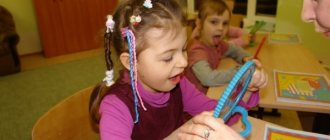As a rule, mental retardation is detected in preschool and primary school age, when the child is faced with the need to remember a lot of information, build logical chains and concentrate on one activity.
This is mainly caused by the slow maturation of the central nervous system, therefore, with timely correction, children with mental retardation catch up with their peers and can study in a regular school. The correction process is complex, subtle and lengthy. Its basis is a trusting relationship with the child and taking into account his individual characteristics. Parents must understand well how their baby feels, thinks, lives, in order to provide him with the necessary help, correctly build a daily routine, study, etc.
Higher mental functions and speech
Memory
Children with mental retardation do not remember information well because their short- and long-term memory capacity is limited and there are mechanical memory impairments. Their memories are fragmentary, incomplete, a lesson just learned is quickly forgotten. Poor memory interferes during class: for example, such a child has to constantly be reminded of the conditions of a task or a rule, he confuses words, etc.
It takes them more tries to remember something, so they need to repeat new information over and over again. When reproducing it, a child with mental retardation also needs more time, since it takes him a long time to find the right words.
Psychologists and neurologists recommend teaching your child various memorization techniques to develop memory and thinking.
Perception
Due to poor memory about many objects, concepts, and phenomena, children with mental retardation develop a fragmented idea: the overall picture is there, but some pieces of the mosaic are missing.
It has been proven that visual material is absorbed much better than verbal material, so when explaining it is necessary to use drawings, simple diagrams, and infographics.
Attention
With mental retardation, it is difficult for a child to maintain attention on one object or activity for a long time; he is constantly distracted by something. Teachers often scold him for restlessness and chatter in class, and his inability to complete the task to the end.
To make activities at school and at home more effective and interesting for the child, it is necessary to organize them so that there is a frequent change of activities. In the room where the child learns lessons there should be no external stimuli - computer, radio, TV.
Thinking
The imaginative thinking of such children is impaired, that is, they cannot imagine in detail a specific situation or object in their minds, which is necessary, for example, in mathematics lessons. Abstract thinking (an abstract search for a solution to a problem, the ability to look at the situation as a whole, without resorting to experience or the senses) and logical thinking (the ability to build cause-and-effect relationships, applying and analyzing previously acquired knowledge) work only if the child is guided by an adult - teacher, mom.
On his own, a child cannot make any general conclusion, classify information, highlight the main characteristics of objects, compare, find differences and commonalities between them, find connections, etc.
Speech
Delayed mental development is often accompanied by speech disorders such as: dyslalia (inability to correctly pronounce sounds with normally developed speech organs), dysgraphia (difficulties in mastering writing) and dyslexia (difficulties in mastering reading).
Children with mental retardation often begin to speak well late, pronounce many sounds incorrectly, have a small vocabulary, and find it difficult to construct a long sentence. Here the help of a speech therapist-defectologist is needed.
Psychological and pedagogical characteristics of a school preparatory group child with mental retardation
Features attention:
attention is not stable and it is not always possible to maintain the child’s attention on tasks or play activities for the required period of time; he avoids tasks that require constant mental effort. The child is easily distracted, as he reacts quickly to surrounding events, the volume of voluntary attention is reduced, and there is a violation of attention switching. Stability is insufficiently developed, attention is quickly exhausted, cannot find distinctive features between objects, and also keep at least 3 objects in the field of view, selectivity of visual attention is not sufficiently formed, does not always independently find a given image among similar ones.
Memory Features:
the mechanical type of memory predominates, the volume of RAM is limited and does not correspond to age, the speed and strength of memorization is insufficient, the child is characterized by inaccurate reproduction and rapid loss of information; cannot talk in detail about the events of his life and the surrounding environment.
Features of thinking:
The child has a predominance of visual-effective thinking, verbal-logical thinking is not sufficiently formed, weakness of the analytical-synthetic function of thinking, he does not always assemble a cut-out picture of 4-6 parts on his own, sometimes the help of a teacher is required, he independently identifies an extra object, but does not always explain why it is extra , with the help of the teacher, builds logical series from a certain group of figures (objects).
The level of generalization is insufficient, clearly knows several generalizing concepts (vegetables, fruits, flowers, birds, trees, animals), generalization is built based on insignificant features, and experiences characteristic difficulties in differentiating what is common and what is different. Performs classifications independently, does not know how to independently compare objects in order to identify similarities and differences; insufficient accuracy and meaningfulness of perception, understanding of the main thing in what is perceived.
Elementary mathematical representations and sensory standards:
Distinguishes between the concepts “big-small”, “long-short”, distinguishes with the help of the concept “high-low”, “wide-narrow”, “thick-thin”. Possesses direct counting within 10 with naming the final number, mechanical reproduction of a sequence of numerals in both forward and reverse order, poor computational skills, difficulties in remembering the visual image of numbers and ratio signs; does not always independently name the “neighbors of a number”, as well as does not always independently identify a given number of objects and does not correlate a given number of objects with the number of fingers or other objects, knows the geometric shapes circle, square, oval, in the passive triangle and primary colors, confuses some tints (pink, purple and blue), determines spatial concepts, knows “top-bottom”, “top-bottom”, incorrectly defines the concepts “left-right”, “left-right”, “left-right” on himself and in relation to himself, the goal accepts, but performs the actions incorrectly chaotic, disorderly, partially knows the concepts of time, knows the seasons, parts of the day “day-night”, poorly differentiates the concepts of morning-evening, confuses the days of the week, names randomly.
Emotional-volitional sphere
Mental retardation especially strongly affects a child’s ability to control his actions, feelings, energy, and will. He is literally in captivity of his own weak emotional-volitional sphere:
- constant sudden mood swings;
- suggestibility, quickly falls under the influence of others;
- frequent manifestations of aggression, outbursts of anger;
- increased anxiety, fear;
- low self-esteem, lack of self-confidence;
- not wanting to do anything;
- inability to act independently;
- hyperactivity;
- often commits actions while in a state of strong excitement, in a state of passion.
Due to the fact that a child with mental retardation speaks poorly, has difficulty distinguishing emotions, he cannot express his own experiences, for example, in time to say that he is tired or upset, he is bored. He is also unable to identify emotions in other people.
A child with mental retardation often looks for a “mentor”, an authoritative peer or an adult to whom he is strongly attached and whom he strives to imitate in everything.
At the same time, mental retardation prevents the child from building normal relationships with peers. He is reluctant to make contact, he is afraid of the team, so he is not accepted into games and events. A child with mental retardation has a greater chance of making friends among younger children, but mostly he will seek solitude. Here the exception is children in whom mental retardation has a constitutional etiology; on the contrary, they are very sociable.
Causes of mental retardation
ZPR in preschool children. Difficulties in development in children are associated with the causes and time of occurrence of pathologies, the degree of damage and the significance of the affected function in the mental development system.
The main groups of factors that provoke ZPR include:
- lack of communication leading to lack of social experience;
- biological factors that prevent the normal maturation of brain structures;
- the presence of various somatic diseases;
- negative social environment in which the child grew up;
- lack of age-appropriate, meaningful activities that allow the child to gain social experience.
Also, the causes of ZPR include unfavorable factors during the mother’s pregnancy or various complications during childbirth:
- maternal diseases of a chronic nature (diabetes mellitus, heart disease, thyroid disease);
- diseases during pregnancy (flu, mumps, rubella);
- toxoplasmosis;
- toxicosis (especially dangerous in the 2nd and 3rd trimester);
- blood incompatibility according to the Rh factor in mother and baby;
- maternal use of hormonal drugs, nicotine, alcohol, and narcotic substances during pregnancy;
- asphyxia of the baby during childbirth or its threat;
- injuries to the child caused by the use of obstetric instruments;
- somatic and infectious diseases of children at an early age;
- damage to the nervous system of babies that occurs after injuries, infections, long-term anesthesia, etc.
Remember! The cause of mental retardation may be a genetic predisposition in the child’s family to pathologies in the mental and mental sphere.
Also, delayed mental development of the secondary type can occur due to defects in the visual system and disturbances in auditory activity, speech deficiencies, which leads to limited communication and a deficit of sensory information.
How to determine whether a child’s psychological development is normal: Dr. Komarovsky
To eliminate speech disorders with a child with mental retardation, group and individual classes are conducted with specialists: psychologist, speech therapist, speech pathologist.
Social teachers and direct educators are also included in correctional work with children.
To work with children with mental retardation and create an adequate program to support such children, it is necessary to take into account the individual characteristics of each child.
Important! If you follow all the recommendations, you can achieve positive dynamics, eliminate most developmental disorders, and even completely remove the diagnosis of mental retardation.
Causes
There are biological and social reasons for the development of mental retardation.
Biological:
- pregnancy pathologies: severe toxicosis, intoxication, infections, injuries;
- prematurity;
- intrauterine fetal hypoxia;
- asphyxia during childbirth;
- infectious, toxic, traumatic diseases at an early age;
- genetic predisposition;
- trauma during childbirth;
- lagging behind peers in physical development;
- somatic diseases (disturbances in the functioning of various organs);
- damage to certain areas of the central nervous system.
Social:
- restriction of life activity for a long time;
- mental trauma;
- unfavorable living conditions;
- pedagogical neglect.
Depending on the factors that ultimately led to mental retardation, several types of disease are distinguished, on the basis of which a number of classifications have been compiled.
Prevention
Among the measures to prevent mental retardation in children are the following:
- Pregnancy planning. Compliance with all doctor’s recommendations when carrying a child, timely visits to medical institutions and completion of all tests and examinations.
- Elimination of negative effects on the fetus during pregnancy, complete abandonment of bad habits.
- Providing positive conditions for the life and development of the child.
- Prevention of somatic and infectious diseases in young children.
Compliance with these preventive measures will significantly reduce the risk of a child developing developmental delays and health problems in general.
Article "Characteristics of mental retardation in preschool children"
Etiopathogenetic characteristics of mental retardation in preschool children.
Delayed mental development is considered a “borderline” form of dysontogenesis and is expressed in a slow rate of maturation of various mental functions. In general, for this condition are character! heterochronicity (multiple times) of manifestation of deviations and significant differences both in the degree of their severity and in the prognosis of consequences. The clinical and psychological-pedagogical literature presents several classifications of mental development in children.
The first clinical classification of mental retardation was proposed in 1967 by T. A. Vlasova S. Pevzner. Within the framework of this classification, two variants of mental development delay were considered. One of them was associated with mental and psychophysical infantilism, in which the lag in the development of the emotional-volitional sphere and the personal immaturity of children comes to the fore. The second option associates cognitive impairment in mental retardation with persistent cerebral asthenia, which is characterized by impaired attention, distractibility, fatigue, psychomotor lethargy or excitability.
M. S. Pevzner believed that slight organic changes in the central nervous system and immaturity of the emotional-volitional sphere should be reversible with proper therapeutic and correctional educational work. Therefore, mental retardation was sometimes defined as a “temporary delay in mental development.” However, as shown by the follow-up studies of M. G. Reidiboym (1971), I. A. Yurkova (1971), M. I. Buyanova (1986), as the traits of emotional immaturity decrease with the age of the child, signs of intellectual immaturity rarely come to the fore. insufficiency, and often psychopathic-like disorders.
The author of the following classification is V.V. Kovalev (1979). He divided mental retardation into dysontogenetic and encephalopathic variants. The first option is characterized by a predominance of signs of immaturity of the frontal-diencephalic parts of the brain, while the second option is characterized by more pronounced symptoms of damage to the subcortical systems. In addition to these two options, the author identified mixed residual neuropsychic disorders - dysontogenetic-encephalopathic.
A later classification based on the etiology and pathogenesis of the main forms of mental retardation was proposed in 1980 by K. S. Lebedinskaya. It entered the literature as an etiopathogenetic classification. In accordance with it, there are four main types of mental retardation:
1) delayed mental development of constitutional origin;
2) delayed mental development of somatogenic genesis;
3) delayed mental development of psychogenic origin;
4) mental retardation of cerebral-organic origin.
• Delayed mental development of constitutional origin. This type of mental retardation includes hereditarily determined mental and psychophysical infantilism - harmonious or disharmonious. In both cases, children are dominated by traits of emotional and personal immaturity, “childish” behavior, lively facial expressions and behavioral reactions. In the first case, mental immaturity is combined with a delicate but harmonious physique; in the second case, the child’s behavior and personal characteristics have pathological properties. This manifests itself in affective outbursts, egocentrism, a tendency to demonstrative behavior, and hysterical reactions. As I. F. Markovskaya (1993) points out, behavioral disorders with disharmonious infantilism are more difficult to respond to psychological and pedagogical correction and require great effort on the part of parents and teachers, therefore additional drug therapy is indicated for such children.
Within the framework of mental retardation of constitutional origin, we also consider hereditarily determined partial deficiency of certain modality-specific functions (praxis, gnosis, visual and auditory memory, speech), which underlie the formation of complex inter-analyzer skills, such as drawing, reading, writing, counting and others . The genetic cause of these disorders is confirmed by cases of left-handedness, dyslexia, dysgraphia, acalculia, and insufficiency of spatial gnosis and praxis passed on from generation to generation in families of children with mental retardation.
In terms of correction, this is one of the most favorable types of mental development for mental retardation.
• Delayed mental development of somatogenic genesis. This type of mental retardation is caused by chronic somatic diseases of the child’s internal organs - heart, kidneys, liver, lungs, endocrine system, etc. They are often associated with chronic diseases of the mother. Severe infectious, repeatedly recurring diseases in their first year of life have a particularly negative impact on the development of children. It is they who cause a delay in the development of children’s motor and speech functions, delay the formation of self-care skills, and make it difficult to change phases of play activity.
The mental development of these children is inhibited primarily by persistent asthenia, which sharply reduces the overall mental and physical tone. Against its background, neuropathic disorders characteristic of somatogenesis develop - uncertainty, timidity, lack of initiative, capriciousness, timidity. Since children grow up under conditions of gentle treatment and overprotection, it is difficult for them to develop positive personal qualities, their circle of friends is narrowed, and the lack of sensory experience affects the replenishment of their ideas about the world around them and its phenomena. Secondary infantilization often occurs, which leads to decreased performance and more persistent mental retardation. Taking into account the combination of all these factors underlies the forecast of the prospects for the further development of the child and in determining the content of therapeutic and preventive, correctional, pedagogical and educational influences on the child.
• Delayed mental development of psychogenic origin. This type of mental retardation is associated with unfavorable upbringing conditions that limit or distort the stimulation of the child’s mental development in the early stages of its development. Deviations in the psychophysical development of children in this variant are determined by the psychotraumatic influence of the environment. Its influence can affect the child even in the womb if a woman experiences strong, long-term negative experiences. Mental retardation of psychogenic origin may be associated with social orphanhood, cultural deprivation, and neglect. Very often, this type of mental retardation occurs in children raised by mentally ill parents, primarily their mother. Disturbances in cognitive activity in such children are due to their poor understanding of the world around them, low performance, lability of the nervous system, lack of formation of voluntary regulation of activity, and specific behavioral and mental characteristics.
Behavioral disorders recorded in these children strongly depend on the uniqueness of situational factors that have a long-term influence on the child. And depending on the individual characteristics of his psyche, various types of emotional reactions arise: aggressive-defensive, passive-defensive, “infantilized” (G. E. Sukhareva, 1959). All of them lead to early neuroticism of the individual. At the same time, some children exhibit aggressiveness, inconsistency of actions, thoughtlessness and impulsiveness of actions, while others exhibit timidity, tearfulness, distrust, fears, and lack of creative imagination and expressed interests. If overprotection prevails on the part of relatives when raising a child, then another type of pathocharacterological development of the personality is noted. These children do not have self-care skills, are capricious, impatient, and are not accustomed to independently solving problems that arise. They have high self-esteem, selfishness, lack of
hard work, inability to empathize and self-restraint, tendency to hypochondriacal experiences.
The effectiveness of correctional measures for this type of mental retardation is directly related to the possibility of restructuring an unfavorable family climate and overcoming a type of family education that pampers or rejects the child.
• Delayed mental development of cerebral-organic origin. The last type of mental retardation among those considered occupies the main place within the boundaries of this deviation. It occurs most often in children and it also causes the most pronounced disturbances in children in their emotional-volitional and cognitive activity in general.
According to I.F. Markovskaya (1993), this type combines signs of immaturity of the child’s nervous system and signs of partial damage to a number of mental functions. She identifies two main clinical and psychological options for mental retardation of cerebral-organic origin.
In the first option, traits of immaturity in the emotional sphere, such as organic infantilism, predominate. If encephalopathic symptoms are noted, they are represented by mild cerebrasthenic and neurosis-like disorders. At the same time, higher mental functions are insufficiently formed, depleted and deficient in the control of voluntary activity.
In the second option, symptoms of damage dominate: persistent encephalopathic disorders, partial violations of cortical functions and severe neurodynamic disorders (inertia, tendency to perseveration) are detected. The regulation of the child’s mental activity is disrupted not only in the area of control, but also in the area of programming cognitive activity. This leads to a low level of mastery of all types of voluntary activities. The child’s development of object-manipulative, speech, play, productive and educational activities is delayed. In a number of cases, we can talk about “displaced sensitivity” in the development of mental functions and in the process of formation of psychological new formations of age.
The prognosis of mental retardation of cerebral-organic origin largely depends on the state of higher cortical functions and the type of age-related dynamics of its development. As noted by I.F. Markovskaya (1993), with the predominance of general neurodynamic disorders, the prognosis is quite favorable. When they are combined with a pronounced deficiency of individual cortical functions, a massive psychological and pedagogical correction is required, carried out in a specialized kindergarten. Primary persistent and extensive disorders of programming, control and initiation of voluntary types of mental activity require distinguishing them from mental retardation and other serious mental disorders.
For the mental sphere of a child with mental retardation, a combination of deficient functions and intact functions is typical. Partial (partial) deficiency of higher mental functions may be accompanied by infantile personality traits and behavior of the child. At the same time, in some cases the child’s ability to work suffers, in other cases - arbitrariness in organizing activities, thirdly - motivation for various types of cognitive activity, etc.
Mental retardation in children is a complex polymorphic disorder in which different children suffer from different components of their mental, psychological and physical activity.
In order to understand what is the primary disorder in the structure of this deviation, it is necessary to recall the structural-functional model of brain function (according to A. R. Luria). In accordance with this model, three blocks are distinguished: the energy block, the block for receiving, processing and storing information, and the block for programming, regulation and control. The coordinated work of these three blocks ensures the integrative activity of the brain and the constant mutual enrichment of all its functional systems.
It is known that in childhood, functional systems with a short development period show a greater tendency to damage. This is typical, in particular, for the medulla oblongata and midbrain systems. Signs of functional immaturity are shown by systems with a longer postnatal period of development - the tertiary fields of the analyzers and the formations of the frontal region. Since the functional systems of the brain mature heterochronically, a pathogenic factor that acts at different stages of the prenatal or early postnatal period of a child’s development can cause a complex combination of symptoms, both mild damage and functional immaturity of various parts of the cerebral cortex.
Subcortical systems provide optimal energy tone of the cerebral cortex and regulate its activity. With non-functional or organic inferiority, children experience neurodynamic disorders - lability (instability) and exhaustion of mental tone, impaired concentration, balance and mobility of the processes of excitation and inhibition, the phenomenon of vegetative-vascular dystonia, metabolic and trophic disorders, affective disorders.
Tertiary fields of analyzers refer to the block for receiving, processing and storing information coming from the external and internal environment. Morpho-functional dysfunction of these areas leads to deficiency of modality-specific functions, which include praxis, gnosis, speech, visual and auditory memory.
The formations of the frontal region belong to the block of programming, regulation and control. Together with the tertiary zones of the analyzers, they carry out complex integrative brain activity - they organize the joint participation of various functional subsystems of the brain for the construction and implementation of the most complex mental operations, cognitive activity and conscious behavior. The immaturity of these functions leads to the emergence of mental infantilism in children, immaturity of voluntary forms of mental activity, and disruption of interanalyzer cortico-cortical and cortico-subcortical connections.
Summarize. Structural-functional analysis shows that in case of ZPR, both individual above-mentioned structures and their main functions in various combinations can be primarily disrupted. In this case, the depth of damage and (or) the degree of immaturity may vary. This is what determines the variety of mental manifestations found in children with mental retardation. Various secondary layers further enhance within-group dispersion within a given category.
When mental development is delayed in children, various etiopathogenetic variants are observed, where the leading causative factor may be:
- low rate of mental activity (cortical immaturity),
- attention deficit with hyperactivity (immaturity of subcortical structures),
- autonomic lability against the background of somatic weakness (due to immaturity or due to weakness of the autonomic nervous system itself against the background of social, environmental, biological reasons),
- vegetative immaturity (as biological lack of endurance of the body),
- energy depletion of nerve cells (due to chronic stress) and others.
The definition of “mental retardation” is also used to characterize deviations in the cognitive sphere in a child with pedagogical neglect caused by social deprivation.
Thus, this definition reflects both biological and social factors in the emergence and development of a condition in which the full development of a healthy organism is hampered and the formation of a personally developed individual is delayed.
Diagnosis of mental retardation
ZPR in preschool children. The diagnosis of mental retardation is most often made in children 4-5 years old. Detecting deviations at an earlier age is extremely problematic.
To identify mental retardation in children and find the causes of deviations, a comprehensive examination by specialists is necessary:
- speech pathologist;
- psychotherapist;
- pediatrician;
- speech therapist;
- pediatric neurologist;
- psychologist.
Before making a diagnosis, the following types of examinations are used:
- Collection and study of anamnesis.
- Consideration of intellectual activity.
- Analysis of the child's medical documentation.
- Study of the baby's living conditions.
- Diagnostic study of speech skills.
- Study of emotional and volitional characteristics.
- Neuropsychological testing.
It is mandatory for specialists to conduct a conversation with children.
Instrumental examinations include CT, EEG and MRI of the baby’s brain.
Based on the research, a diagnosis of mental retardation is made, and parents are given recommendations on raising a child and studying in a specialized preschool institution for children with developmental disorders.







